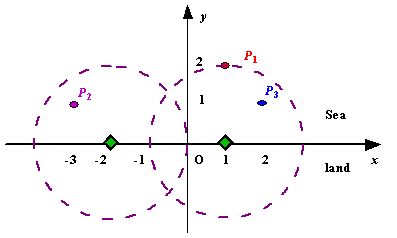POJ Problem Radar Installation 【贪心】
Description
Assume the coasting is an infinite straight line. Land is in one side of coasting, sea in the other. Each small island is a point locating in the sea side. And any radar installation, locating on the coasting, can only cover d distance, so an island in the
sea can be covered by a radius installation, if the distance between them is at most d.
We use Cartesian coordinate system, defining the coasting is the x-axis. The sea side is above x-axis, and the land side below. Given the position of each island in the sea, and given the distance of the coverage of the radar installation, your task is to write a program to find the minimal number of radar installations to cover all the islands. Note that the position of an island is represented by its x-y coordinates.  Figure A Sample Input of Radar Installations Input
The input consists of several test cases. The first line of each case contains two integers n (1<=n<=1000) and d, where n is the number of islands in the sea and d is the distance of coverage of the radar installation. This is followed by n lines each containing
two integers representing the coordinate of the position of each island. Then a blank line follows to separate the cases.
The input is terminated by a line containing pair of zeros Output
For each test case output one line consisting of the test case number followed by the minimal number of radar installations needed. "-1" installation means no solution for that case.
Sample Input 3 2 1 2 -3 1 2 1 1 2 0 2 0 0 Sample Output Case 1: 2 Case 2: 1 Source |
海上的每一个岛到陆地上最远距离d有两个点,当雷达在这两个点所确定的区域时,这个岛就在雷达所在的范围内。所以就将这个问题化为贪心的区间覆盖问题。将所有岛的区间左端点进行升序排列,每次使右端点所能包含的线段数目最大(答案为统计左右不重合的线段的数目)。
#include <cmath>
#include <cstdio>
#include <cstring>
#include <algorithm>
#define MAX_N 1010
#define MAX(a, b) ((a > b)? a: b)
#define MIN(a, b) ((a < b)? a: b)
using namespace std;
const int INF = 1e8;
struct node{
double l, r;
}pon[MAX_N];
bool cmp(node x, node y) {
return x.l < y.l;
}
int main() {
int n, d;
double x, y;
int cnt = 0;
while (scanf("%d%d", &n, &d), n||d) {
int ans = 0;
bool flag = false;
for (int i = 0; i < n; i++) {
scanf("%lf%lf", &x, &y);
if (y > d) {
flag = true;
}
pon[i].l = x - sqrt(d*d - y*y);
pon[i].r = x + sqrt(d*d - y*y);
}
if (flag) {
printf("Case %d: -1\n", ++cnt);
continue;
}
sort(pon, pon + n, cmp);
double t = pon[0].r;
for (int i = 1; i < n; i++) {
if(pon[i].l > t) {
t = pon[i].r;
ans++;
}
//如果当前的右端点大于pon[i].r,则当前的右端点应等于pon[i].r
else if(pon[i].r < t) {
t = pon[i].r;
}
}
printf("Case %d: %d\n", ++cnt, ans + 1);
}
return 0;
}


 浙公网安备 33010602011771号
浙公网安备 33010602011771号